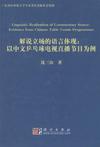解说立场的语言体现
出版时间:2010-11 出版社:科学出版社 作者:沈三山 页数:284
Tag标签:无
内容概要
《解说立场的语言体现:以中文乒乓球电视直播节目为例》用英文撰写了从1987年到2002年中央电视台乒乓球比赛的部分录像,进行了两个具有一定深度的话语立场调查。结果发现:在一场中外乒乓球选手之间比分非常接近的比赛中,依据交替击技的客观事实,解说轮次在中外比赛双方之间的分布是不均匀的;依据赛尔的言语行为适切条件以及中国人中文语感的调查,确认并定义了八种常用的言语行为,使用这一言语行为分类对转写材料进行加标和统计,发现解说中各种言语行为在两个选手之间的分布差异具有统计上的显著意义。
书籍目录
Acknowledgements前言AbstractChapter 1 Introduction1.1 The Object of Research1.2 Chinese Table Tennis Commentary1.3 Stance in Chinese Table Tennis Commentary1.4 General Approach1.5 Organization of the BookChapter 2 Literature Review2.1 Introduction2.2 Sports Announcer Talk2.2.1 SAT as a register or genre2.2.2 Linguistic features of SAT2.2.3 Key information tiers in a SAT2.2.4 Methodology in SAT research2.2.5 Professional experience in producing a SAT2.2.6 Summary on the review of previous SAT researches2.3 Linguistic Theory of Evaluation2.3.1 Affection in lexis2.3.2 Stance in sentence2.3.3 Evaluation in discourse2.4 Speech Act Theory2.4.1 Why Speech Act Theory?2.4.2 A brief introduction to Speech Act Theory2.4.3 What other speech act does a constative utterance usually perform?2.4.4 Is there an alternative way to classify speech acts?2.4.5 What is the relationship between and among speech acts?2.4.6 Summary on the review of Speech Act Theory2.5 Discussion and Summary2.5.1 Discussion2.5.2 SummaryChapter 3 Research Methodology3.1 General Hypothesis3.2 Data Collection, Transcription and Process3.2.1 Data selection3.2.2 Data transcription3.2.3 Data processing3.3 Competition in Table Tennis and Comparison in CITC3.3.1 Aspects of CTFC: objective or subjective3.3.2 Comparative categories3.4 Two Key Comparisons3.4.1 Selection of point, stroke, or performance for evaluation3.4.2 Speech act allocation and analysis3.4.3 Evaluation patterns and their allocation3.5 Discussion and Summary3.5.1 Discussion3.5.2 SummaryChapter 4 A General Description of CTTC4.1 Introduction4.2 General Description of CTTC4.3 Basic Statistics4.3.1 Constant frequency of different commentaries4.3.2 Discourse usages and patterns4.4 General Structure of a CT]?C4.4.1 Information tiers4.4.2 Evaluation distribution4.5 Discussion and Summary4.5.1 Discussion4.5.2 SummaryChapter 5 Selection of Points and Strokes for Commentary5.1 Introduction5.2 Basic Concepts5.2.1 Basics of table tennis stroke5.2.2 Alternate strokes5.2.3 Pilot transcription of alternate strokes by the author5.2.4 Transcription of alternate strokes by coaches5.2.5 General summary5.3 Competition Point and Commentary Unit5.3.1 Score reports and game stages5.3.2 Commentary unit5.3.3 Stage contents and their organization5.4 Stage Perspective and Commentary Stance5.4.1 Basic perspectives5.4.2 Stage perspective5.4.3 Commentary distribution5.4.4 Commentary stance5.5 Summary and Discussion5.5.1 Summary5.5.2 DiscussionChapter 6 Category and Distribution of Speech Acts6.1 Introduction6.2 Commentator, Audience and Player in a CTTC6.3 Speech Acts in a CTTC6.3.1 Definition and category6.3.2 Speech act tagging6.4 Distribution of Speech Acts in a CTTC6.5 Macro Speech Act6.6 Summary and Discussion6.6.1 Summary6.6.2 DiscussionChapter 7 Conclusion7.1 Major Findings and Contributions7.2 Conclusions7.3 Limitations and Further Studies7.3.1 Limitations7.3.2 Further studiesReferencesAppendix 1 Details of the Research DataAppendix 2 Glossary of Table TennisAppendix 3 A Sample CTTCAppendix 4 English Translation of the Sample CTTCAppendix 5 Alternate Strokes TranscriptionAppendix 6 Intuition ConsultationAppendix 7 Statistics of Speech Act Allocation
章节摘录
版权页:插图:In Example 1-1, a good performance or stroke is accordinglyevaluated and it is interesting in that by using the expressionas eve-ryone can see, Liu's mind can beseen, but that is commentary inwhich the commentator tries to guide and lead the audience's atten-tion. In Example 1-2, Jiang's backhand is negatively evaluated, thoughfrom a positive perspective that is more polite. That is a commenta-tor's usual principle and practice, i.e. to be moderate in evaluation ofthe poor performance or status. In Example 1-3, the evaluation is asubtle comparison: the loser is first praised in detail and the winner isthen praised even more but the praise of latter is somewhat overdonefor a purpose that makes the audience agree that the losing is not anunforced error for the loser. Considering the unusual and outstandingperformance of his opponent, the loser might be excused while thewinner is highly praised. From the three examples above, in additionto the propositional content, an important aspect of evaluation can beseen, that is, the attitude the commentator takes while evaluating, ei-ther positive, negative or in a more subtle or sophisticated way. No-tice that they are about various aspects of a competition: different par-ticipants, strokes, performances and so on; and they are local in asense because they reside within individual utterances that are fineparts of a complete commentary. Then a question here arises: should various evaluations be com-prehended individually or relatively if they all occur in a particularpiece of commentary? Since the key part of a Chinese table tenniscommentary consists of utterances of various evaluations, there is aneed to explain the relationship among these utterances to seewhether they are related in a way and thus the coherent parts of aChinese table tennis commentary.
编辑推荐
《解说立场的语言体现:以中文乒乓球电视直播节目为例》:广东外语外贸大学学术著作出版基金资助。
图书封面
图书标签Tags
无
评论、评分、阅读与下载
